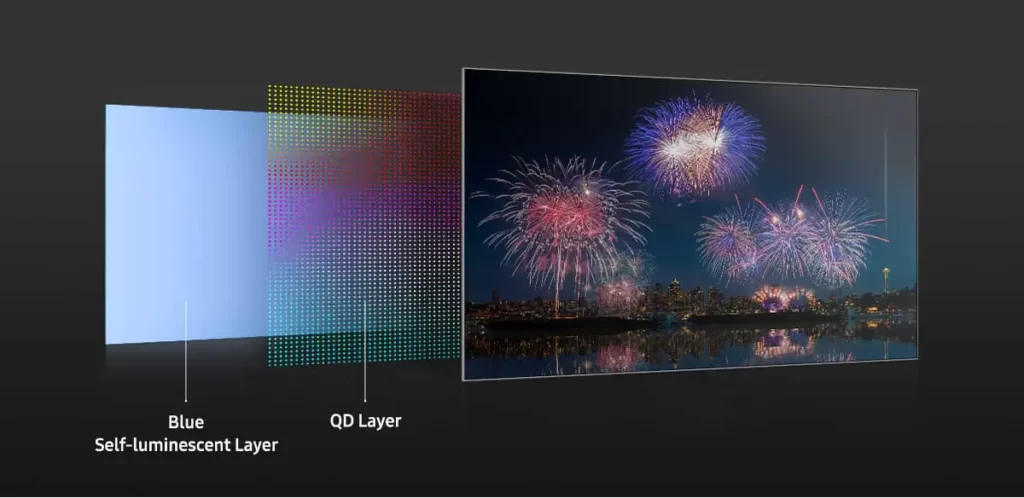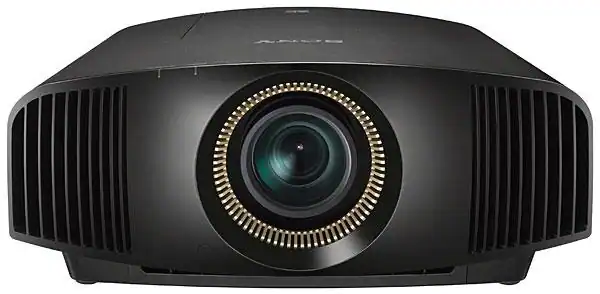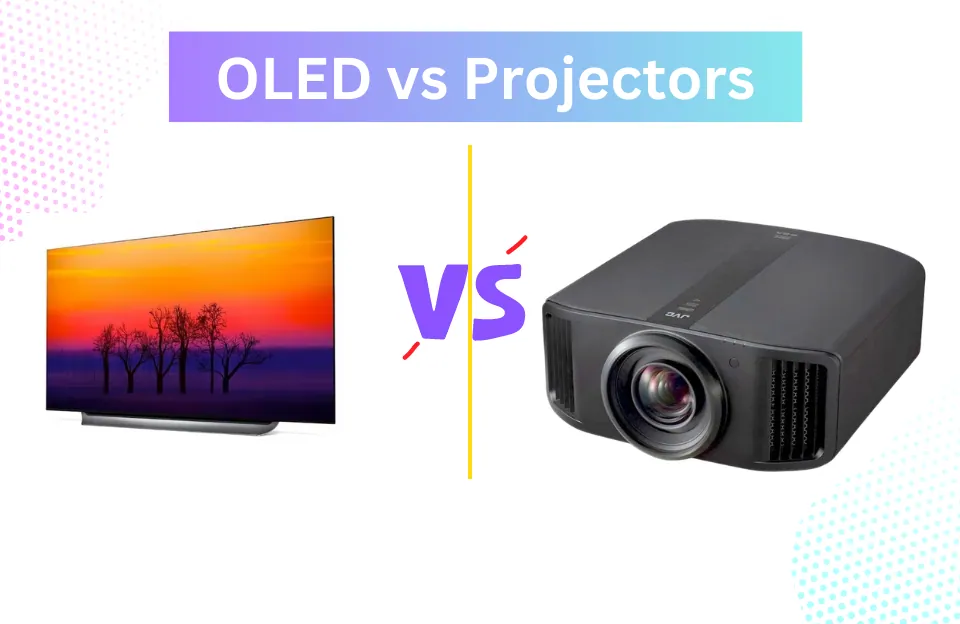In the world of display technologies, OLEDs and Projectors are two popular options that offer unique advantages. OLED, or Organic Light Emitting Diode, is a cutting-edge technology known for its vibrant colors and deep black levels.
On the other hand, projectors provide a large-screen viewing experience that can turn any room into a theater-like environment.
Two popular options mentioned above have gained widespread attention these days. Both offer unique features and benefits, but they cater to different preferences and use cases.
Here, in this article, we will compare OLED displays vs Projectors to help you make an informed decision based on your specific requirements. So let’s dive in and explore the battle between OLED vs Projectors.
Explaining OLED Technology

OLED (Organic Light-Emitting Diode) is a display technology that utilizes organic compounds to emit light when an electric current is applied. Each pixel in an OLED display emits its own light, allowing for deep blacks, vibrant colors, and high contrast ratios.
Unlike traditional LCD displays that require a backlight, OLED displays are self-emissive, resulting in better energy efficiency and thinner form factors.
The Advantages of OLED Displays
OLED displays offer several advantages, which are explained below. These displays excel in delivering stunning visuals and are commonly found in high-end smartphones and premium TVs.
Perfect Black Levels and Contrast Ratio
One of the standout features of OLED displays is their ability to achieve true black levels. Since each pixel can be turned off completely, OLED screens can display pure black, enhancing the contrast ratio and making colors appear more vibrant and lifelike.
Wide Color Gamut
OLED displays offer an extensive color gamut, reproducing colors with remarkable accuracy. This wide range of colors ensures a more immersive visual experience, especially when viewing content that is rich in color, such as movies and video games.
Fast Response Time
OLEDs have an impressive response time, virtually eliminating motion blur in fast-paced scenes, which is especially advantageous for gaming and action movies.
Energy Efficiency
Since OLED pixels emit their light individually, OLED displays consume less power when displaying darker content, contributing to energy efficiency.
Limitations of OLED Displays
Burn-in Issues
OLED displays are susceptible to burn-in, where static images or logos displayed for prolonged periods can cause permanent image retention, potentially affecting long-term performance.
Cost
OLED displays are generally more expensive than traditional LCDs or projectors, making them less accessible to budget-conscious consumers.
Lifespan
Although OLED technology has come a long way in improving its lifespan, it still falls short compared to traditional LED-backlit displays.
Exploring Projectors

Projectors, on the other hand, are devices that project images or videos onto a screen or surface. They utilize light sources and lenses to create enlarged images from a video source.
Projectors have been a staple in the world of home theaters and professional presentations for many years. Recent advancements have made projectors more capable, versatile, and affordable, giving OLED displays some serious competition.
The Advantages of Projectors
Projectors offer the benefit of large-screen viewing, making them ideal for creating immersive cinematic experiences at home or in commercial settings. Below are the advantages of projectors given:
Large Screen Experience
Projectors offer the advantage of projecting content onto larger screens, delivering a cinematic and immersive experience that surpasses most traditional televisions.
Versatility
Projectors can be easily moved and set up in various locations, allowing users to enjoy a large screen experience in different rooms or even outdoors.
Cost-Effectiveness
When it comes to large screen sizes, projectors often provide a more cost-effective solution compared to purchasing a similarly sized OLED display.
Limitations of Projectors
Image Quality
While projectors have improved significantly, they still struggle to match the image quality offered by OLED displays, particularly in terms of black levels and contrast ratios.
Ambient Light Interference
Projectors are more susceptible to ambient light interference, making them less suitable for bright rooms or environments with less control over lighting conditions.
Bulb Replacement
Traditional projectors rely on bulbs that have a limited lifespan and require periodic replacement, adding to the maintenance cost over time.
Recommended:
- Projector Screen vs. Wall
- PG 13 vs TV 14: What You Need to Know!
- How To Clean A Projector Screen (Top Secrets Revealed!)
- Learn How To Hang A Projector Screen Like A Pro!
- Projector In Basement: Turn Your Basement into a Home Theater Haven
- Best Cheap Projector For PowerPoint Presentations
OLED vs Projectors: A Quick Comparison Table
| Factor Of Difference | OLED Displays | Projectors |
|---|---|---|
| Picture Quality | Vibrant colors, true blacks, high contrast ratios | Limited contrast and color accuracy may vary |
| Size and Portability | Fixed screens, not easily portable | Compact, and portable, can create a large-screen setup |
| Cost | Expensive, especially for larger screen sizes | More affordable, and cost-effective for large screens |
| Versatility and Use Cases | Primarily used for home entertainment, gaming, and professional applications | Versatile, suitable for various settings and purposes |
| Viewing Environment | Performs well in both dark and well-lit rooms | Affected by ambient light, requires controlled lighting |
| Energy Efficiency | Consumes less power due to individual pixel control | Requires significant power for bright images |
| Lifespan and Durability | Limited lifespan, proper usage can prolong the lifespan | Longer lifespan with maintenance and bulb replacements |
| Installation and Setup | Relatively straightforward | Requires alignment, positioning, and calibration |
| User Experience and Interface | Intuitive operating systems, smart features | May require additional devices for convenience |
| Maintenance | Basic cleaning and usage care | Regular maintenance, bulb replacements |
| Advancements and Future Trends | Ongoing improvements in lifespan and burn-in issues | Compact size, improved brightness, and connectivity |
OLED vs Projectors: A Detailed Comparison

Which Will Dominate?
When choosing between OLED displays and projectors, several factors come into play. Here are some key considerations:
1. Image Quality
OLED image quality
OLED displays are renowned for their exceptional image quality. They deliver deep blacks, high contrast ratios, and vibrant colors, resulting in visually stunning content. As we’ve discussed above in an OLED, each of the pixels emits light which provides precise control over brightness and overall image quality.
Projector image quality
Projectors can provide impressive image quality, particularly when used in a controlled environment. The quality depends on factors such as resolution, brightness, contrast ratio, and color accuracy. Higher-end projectors can deliver sharp images with good color reproduction.
Comparing image quality
When it comes to image quality, OLED displays generally outperform projectors. The self-emitting pixels in OLED displays ensure deep blacks, accurate colors, and excellent contrast. Projectors can offer impressive image quality, but they may struggle to achieve the same level of precision and contrast due to their reliance on external lighting conditions.
2. Display Size and Portability
OLED display size
OLED displays are available in a wide range of sizes, from small smartphone screens to large TVs. They are often used in devices where compactness and portability are desirable, such as smartphones, tablets, and laptops. However, the largest OLED TVs can be quite expensive.
Projector display size
Projectors offer tremendous flexibility in terms of display size. They can project images onto screens or surfaces of various sizes, allowing for a customizable viewing experience. Projectors are particularly popular for creating home theaters with large cinematic screens.
Portability considerations
In terms of portability, OLED displays have an advantage due to their compact size and integration into portable devices. Projectors, on the other hand, require additional equipment, such as screens or walls, and may not be as portable. However, there are portable projectors available that offer convenience for on-the-go use.
3. Contrast and Black Levels
OLED contrast and black levels
OLED displays excel in delivering deep blacks and high contrast ratios. Since each pixel emits its own light, OLED displays can turn off individual pixels completely, resulting in true blacks. This characteristic enhances the overall viewing experience, especially in dark scenes or content with high contrast.
Projector contrast and black levels
Projectors rely on external lighting conditions, which can impact their contrast and black levels. While projectors can produce good contrast, they may not match the deep blacks of OLED displays. Ambient light and the quality of the projection surface can influence the perceived contrast and black levels.
Evaluating the differences
When it comes to contrast and black levels, OLED displays have the advantage. Their ability to deliver true blacks creates a more immersive and visually striking experience. Projectors can provide good contrast, but external factors can limit their performance in brightly lit environments.
4. Color Accuracy
OLED color accuracy
Talking about OLED displays, these displays come with excellent color accuracy. OLED technology can produce vibrant and lifelike colors, making it popular among professionals in fields such as graphic design and photography.
Projector color accuracy
Projectors can deliver good color accuracy, but achieving the same level as OLED displays can be challenging. Factors like the quality of the projection surface, ambient light, and color calibration settings can influence color reproduction. High-end projectors with advanced color management systems can provide more accurate colors.
Which is better for accurate colors?
For accurate color reproduction, OLED displays are generally the preferred choice. Their individual pixel control and color precision make them ideal for applications that demand accurate and vibrant colors. Projectors can offer satisfactory color reproduction, but OLED technology sets a higher standard in this aspect.
5. Power Consumption
OLED power consumption
OLED displays are known for their energy efficiency. Since each pixel emits its own light, OLED displays do not require a backlight, resulting in lower power consumption. OLED technology enables precise control over brightness levels, further optimizing energy usage.
Projector power consumption
Projectors typically consume more power compared to OLED displays. They require a light source and additional components to project images onto a surface. The brightness settings, projection size, and usage duration can affect the power consumption of projectors.
Assessing Energy Efficiency
In terms of energy efficiency, OLED displays have the advantage. Their self-emitting pixel technology and control over brightness contribute to lower power consumption. However, it’s worth noting that power consumption can vary depending on usage patterns, screen size, and brightness settings for both OLED displays and projectors.
6. Environment and Lighting
OLED performance in different environments
OLED displays perform well in various lighting conditions. They offer wide viewing angles, ensuring consistent image quality even when viewed from different positions. OLED technology’s ability to deliver deep blacks and vibrant colors makes it suitable for both dimly lit and well-lit environments.
Projector performance in different environments
Projector performance can vary depending on the lighting conditions in the environment. Projected images can appear washed out or less vibrant in brightly lit settings. Controlled lighting environments, such as dedicated home theaters or conference rooms, are more conducive to optimal projector performance.
Considering lighting conditions
When choosing between OLED displays and projectors, it’s essential to consider the lighting conditions in the intended usage environment. OLED displays offer consistent performance across different lighting scenarios, while projectors may require controlled lighting environments for the best image quality.
7. Cost Considerations
OLED costs
OLED displays are generally more expensive compared to other display technologies. The manufacturing process and the use of organic materials contribute to higher production costs, which are reflected in the retail prices. OLED displays are commonly found in premium smartphones, high-end TVs, and professional-grade monitors.
Projector costs
Projectors can have a wide price range, depending on factors such as image quality, resolution, brightness, and additional features. Entry-level projectors can be affordable, making them accessible for home use. However, high-end projectors with advanced specifications and features can be more expensive.
Long-term expenses
When considering costs, it’s essential to evaluate both upfront prices and long-term expenses. OLED displays may have higher initial costs, but they generally consume less power and require less maintenance compared to projectors. Projectors may have lower upfront costs but can incur additional expenses over time, such as lamp replacements.
8. Application Areas
Best scenarios for OLED displays
OLED displays excel in applications that prioritize image quality, color accuracy, and compactness. They are commonly used in smartphones, tablets, laptops, and high-end TVs where vibrant visuals and slim form factors are crucial. OLED displays are also favored by professionals in fields like design, photography, and video editing.
Ideal applications for projectors
Projectors are well-suited for scenarios that require large-screen viewing and flexibility in screen size. They are popular in home theaters, classrooms, conference rooms, and outdoor events. Projectors offer a cinematic experience and can create immersive visuals on a larger scale.
Choosing based on the Use Case
Choosing between OLED displays and projectors depends on the intended use case. If portability, individual pixel control, and vibrant colors are essential, OLED displays are the preferred choice. On the other hand, if large-screen viewing, flexibility, and creating immersive environments are priorities, projectors are the better option.
9. Flexibility and Customization
Customization options for OLED displays
OLED displays offer customization options, particularly in terms of screen size and form factors. Their flexibility allows manufacturers to create curved screens, flexible displays, and unique designs. OLED technology’s versatility enables the development of innovative devices with unique form factors.
Customization options for projectors
Projectors provide flexibility in terms of screen size, as they can project images onto various surfaces. Additionally, projectors can be used with different screens or projection materials to enhance the viewing experience. There are also portable projectors available, offering convenience and flexibility in various settings.
Tailoring to specific needs
The choice between OLED displays and projectors depends on the specific customization needs. If unique form factors and screen designs are desired, OLED displays offer more possibilities. However, if customizable screen sizes and adaptable projection surfaces are required, projectors provide greater flexibility.
10. Longevity and Durability
OLED Lifespan
The lifespan of OLED displays can vary depending on factors such as usage patterns and screen brightness settings. OLED technology has improved over the years, and modern OLED displays generally offer satisfactory durability. However, the risk of burn-in or image retention should be considered, especially with static content displayed for extended periods.
Projector Lifespan
Projectors typically have a longer lifespan compared to individual OLED displays. However, projectors may require maintenance, such as replacing lamps, to ensure optimal performance over time. The lifespan of projectors can vary based on usage, lamp quality, and maintenance practices.
Considering Longevity and Durability
Both OLED displays and projectors have their considerations regarding longevity and durability. While projectors may have a longer overall lifespan, OLED displays have improved in terms of durability and offer longer-lasting performance compared to earlier iterations. It’s important to follow manufacturer recommendations for both types of devices to maximize their lifespan.
OLED vs Projectors: FAQs

Can projectors achieve the same image quality as OLED displays?
Projectors can provide good image quality, but they may not match the precise colors and deep blacks of OLED displays. Factors such as lighting conditions and the quality of the projection surface can influence image quality.
Are OLED displays more expensive than projectors?
Generally, OLED displays are more expensive than projectors. The manufacturing process and use of organic materials contribute to the higher cost of OLED displays. Projectors have a wider price range, with more affordable options available.
Do OLED displays suffer from burn-in issues?
OLED displays can experience burn-in issues if static images are displayed for extended periods. However, modern OLED displays have implemented various technologies to reduce the risk of burn-in.
Do projectors require a dedicated projection surface?
While dedicated projection screens can enhance image quality, projectors can also be used with suitable wall surfaces or projector screens to achieve satisfactory results.
Are projectors suitable for outdoor use?
Yes, projectors can be used outdoors for activities such as outdoor movie screenings or events. However, ambient light and weather conditions can affect the viewing experience.
Can projectors be easily moved between rooms?
Yes, projectors are generally portable and can be moved between rooms as long as there is a suitable projection surface or screen available in each room.
Final Thoughts
In the battle of OLED displays vs. projectors, both have their strengths and applications. OLED displays excel in image quality, color accuracy, and portability, making them ideal for devices like smartphones and premium TVs.
Projectors offer large-screen viewing, flexibility, and customizable screen sizes, making them popular in home theaters and professional settings.
Therefore, the choice between OLED displays and projectors ultimately depends on individual preferences, use cases, and budget constraints.
Both OLED displays and projectors have their place in the world of visual technology, catering to different needs and providing unique viewing experiences. Thanks For Reading!
As an experienced Software Engineer in a Projection-Based Technology Company, I love sharing my Knowledge to utilize and help others to learn more about Projectors. Thus one can get the right Projector for their needs.



